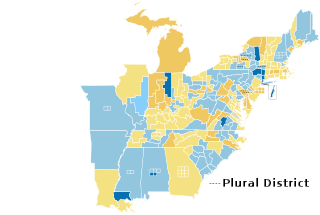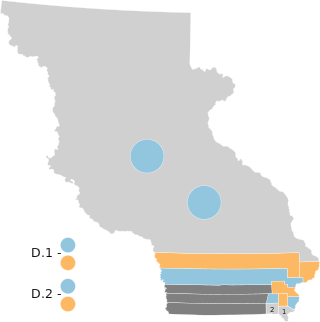
The Territory of Wisconsin was an organized and incorporated territory of the United States that existed from July 3, 1836, until May 29, 1848, when an eastern portion of the territory was admitted to the Union as the State of Wisconsin. Belmont was initially chosen as the capital of the territory. In 1837, the territorial legislature met in Burlington, just north of the Skunk River on the Mississippi, which became part of the Iowa Territory in 1838. In that year, 1838, the territorial capital of Wisconsin was moved to Madison.

The 1840–41 United States House of Representatives elections were held on various dates in various states between July 6, 1840 and November 2, 1841. Each state set its own date for its elections to the House of Representatives, before or after the first session of the 27th United States Congress convened on May 31, 1841. Elections were held for all 242 seats, representing 26 states.

The 1839—1840 United States Senate election in New York was held on February 5, 1839 and January 14, 1840. Incumbent Senator Nathaniel P. Tallmadge was re-elected to a second term in office over scattered opposition.

The 1840–41 United States Senate elections were held on various dates in various states. As these U.S. Senate elections were prior to the ratification of the Seventeenth Amendment in 1913, senators were chosen by state legislatures. Senators were elected over a wide range of time throughout 1840 and 1841, and a seat may have been filled months late or remained vacant due to legislative deadlock. In these elections, terms were up for the senators in Class 2.

The 1838–39 United States Senate elections were held on various dates in various states. As these U.S. Senate elections were prior to the ratification of the Seventeenth Amendment in 1913, senators were chosen by state legislatures. Senators were elected over a wide range of time throughout 1838 and 1839, and a seat may have been filled months late or remained vacant due to legislative deadlock. In these elections, terms were up for the senators in Class 1.

The 2018 United States state legislative elections were held on November 6, 2018, for 87 state legislative chambers in 46 states. Across the fifty states, approximately 56 percent of all upper house seats and 92 percent of all lower house seats were up for election. Additionally, six territorial chambers in four territories and the District of Columbia were up as well.

In the 1838 Iowa Territory Council elections, electors selected councilors to serve in the first Iowa Territory Council. All 13 members of the Territory Council were elected. Councilors served one-year terms.

In the 1839 Iowa Territory Council elections, electors selected councilors to serve in the second Iowa Territory Council. All 13 members of the Territory Council were elected. Councilors served one-year terms.

In the 1840 Iowa Territory Council elections, electors selected councilors to serve in the third Iowa Territory Council. All 13 members of the Territory Council were elected. Councilors served one-year terms.

In the 1842 Iowa Territory Council elections, electors selected councilors to serve in the fifth Iowa Territory Council. All 13 members of the Territory Council were elected. Councilors served one-year terms.

In the 1843 Iowa Territory Council elections, electors selected councilors to serve in the sixth Iowa Territory Council. All 13 members of the Territory Council were elected. Councilors served one-year terms.

In the 1844 Iowa Territory Council elections, electors selected councilors to serve in the seventh Iowa Territory Council. All 13 members of the Territory Council were elected. Councilors served one-year terms.

In the 1845 Iowa Territory Council elections, electors selected councilors to serve in the eighth and final Iowa Territory Council before Iowa attained statehood in 1846. All 13 members of the Territory Council were elected. Councilors served until the organization of the Iowa General Assembly in 1846 as the legislative branch of the new state of Iowa.

In the 1846 Iowa State Senate elections, Iowa voters elected state senators to serve in the first Iowa General Assembly. Elections were held for all 19 members of the State Senate. In the newly created Senate, members were to serve four-year terms. Members of the first General Assembly were classified into two groups. Nine of the newly elected senators would serve full four-year terms, while 10 drew short terms of two years and were up for re-election in 1848. This classification process began the rotation system whereby half the members of the Senate are elected biennially for full four-year terms.

In the 1848 Iowa State Senate elections, Iowa voters elected state senators to serve in the second Iowa General Assembly. Elections were held for 10 of the state senate's 19 seats. State senators serve four-year terms in the Iowa State Senate.

In the 1850 Iowa State Senate elections, Iowa voters elected state senators to serve in the third Iowa General Assembly. Elections were held for 11 of the state senate's 19 seats. State senators serve four-year terms in the Iowa State Senate.

In the 1852 Iowa State Senate elections, Iowa voters elected state senators to serve in the fourth Iowa General Assembly. Following the expansion of the Iowa Senate from 19 to 31 seats in 1852, elections were held for 22 of the state senate's 31 seats. State senators serve four-year terms in the Iowa State Senate.

In the 1854 Iowa State Senate elections, Iowa voters elected state senators to serve in the fifth Iowa General Assembly. Elections were held for 19 of the state senate's 31 seats. State senators serve four-year terms in the Iowa State Senate.

In the 1856 Iowa State Senate elections, Iowa voters elected state senators to serve in the sixth Iowa General Assembly. Following the expansion of the Iowa Senate from 31 to 36 seats in 1856, elections were held for 21 of the state senate's 36 seats. State senators serve four-year terms in the Iowa State Senate.
Mortimer Phillips Bainbridge was an American politician.











